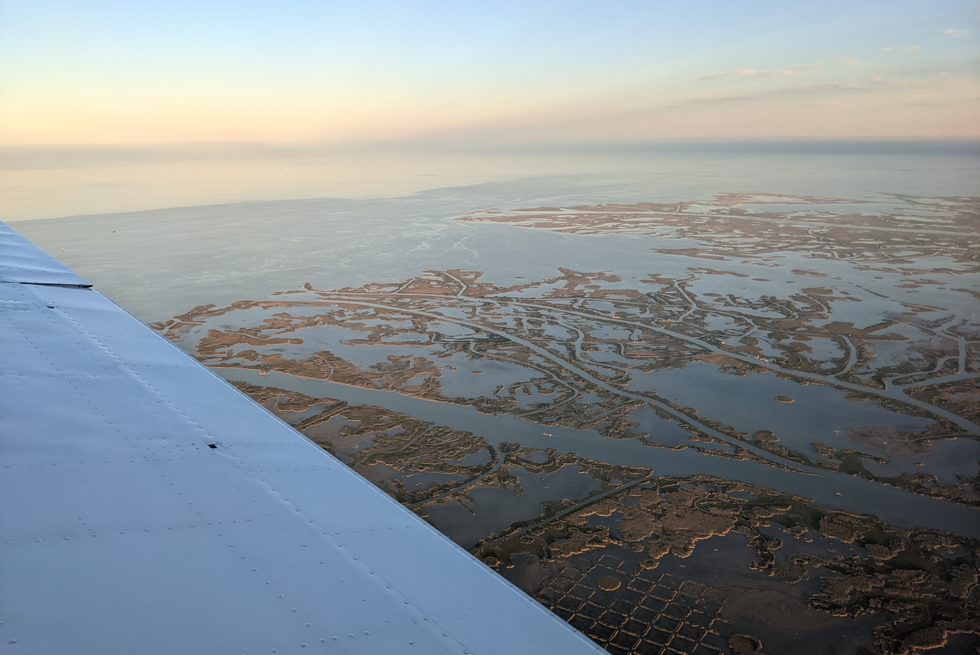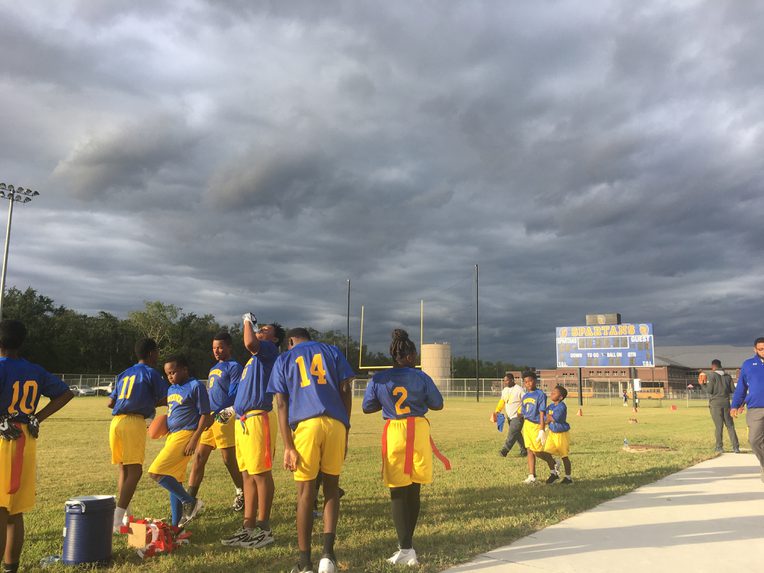Restoration and Reparations: Imagining Coastal Repair
From the Series: Coastal Futures
From the Series: Coastal Futures

Forty miles down the Mississippi River, south of New Orleans, a passionate game of flag football breaks out under a brooding summer sky. Gray clouds cut-through with bright sunlight roll over coastal marshes, creating a dramatic scene for the crowd of cheering mothers, teachers, neighbors, and friends in the small set of bleachers behind Phoenix High School in southern Plaquemines Parish. The joyous exclamations and laughter in the stands give no indication of the ominous projections of flood risk from storm surge and sinking coastal wetlands that has garnered Plaquemines the distinction of being “one of the fastest disappearing places on Earth” (Kolbert 2019).

Phoenix is one of several communities on the southeastern bank of the Mississippi River with a history rooted in enslaved Africans’ contributions to the region’s sugar plantation economy and the evolution of coastal engineering. Despite facing the challenges of chronic environmental catastrophes set in motion by these histories, Phoenix residents have rebuilt their homes and community networks time and again, continuing to plan summer tag football games, family reunions, Mardi Gras celebrations, plant backyard gardens, and even build a local museum.[1] Their persistence is juxtaposed with the stark reality of anti-Black racism and rampant natural resource extraction that has constituted the Plantationocene (Davis et al. 2019).
Louisiana has invested significant finances in large-scale climate change adaptation and wetlands restoration over the past decade, including several diversions of the lower Mississippi River into the sinking marshes of southern Plaquemines. While these restoration projects promise long-term protection for all of southern Louisiana by “working with nature,” policymakers have offered home elevation or relocation as the only long-term adaptation options for people that call southern Plaquemines home. These “necessary tradeoffs” to save the coast have caused deep divisions between state agencies, coastal scientists, and the people, prompting community leaders to question how restoration will “do justice” for those who bear the greatest environmental burdens of coastal wetlands loss.
In his recent book Reconsidering Reparations (2022), philosopher Olúfẹ́mi Táíwò argues that global climate change exemplifies the enduring impacts of global racial empire. South Louisiana serves as a prime example, where settler colonialism, chattel slavery, racialized economic oppression, and natural resource extraction converge into the climate crisis—a crisis that renders places like Phoenix, and neighboring Indigenous communities like Grand Bayou and Isle de Jean Charles, largely expendable in the eyes of policymakers (Barra 2021; Jessee 2021).[2]
If, as Táíwò insists, our collective response to climate change is where a “politically serious reparations project must begin” (Táíwò 2022, 11), how might contemporary conversations about reparations impact the ways we think and practice ecological restoration?
Reparations, Táíwò argues, should not be solely focused on fixing past harms, but on rebuilding the world in ways that improve the conditions of those facing the greatest burdens of climate change and un-doing the frameworks of global racial empire that produced those inequalities in the first place. The focus on construction—on new modes of relating to the Earth and to each other—draws our attention to the relations, particularly relations of survival, at the heart of critical conversations about reparations and ecological restoration.
For many Indigenous peoples, restoration is a reciprocal practice, one of making kin across human and non-human worlds, wherein the restoration of land and culture go hand in hand (Kimmerer 2011). For Afro-descendant peoples and communities in former slaveholding societies like the United States, kinship with seemingly foreboding environments have long been central to survival and freedom (Stewart 2006; Roane 2019). As histories of petit marronage in the nineteenth century and collective farming and fishing in the twentieth century demonstrate, foreboding swamps, coastal wetlands, and seemingly degraded forest lands were key accomplices to the ecology of Black liberation (Hosbey and Roane 2018; White 2019; Purifoy 2022; Barra 2023).
Attending to self-determined forms of liberation and survival, Jovan Scott Lewis proposes the idea of “relational repair” as an approach to reparations oriented around the “affirmation of Black life and framed by the claims of Black people” (Lewis 2023). Beyond merely seeking justice through “the naming of names, the exposure of public secrets, and the articulation of chains of causality” (Thomas 2019, 212), relational repair attends to cultivation care, mutual recognition, and accountability as an ongoing practice of reparation. In this light, reparations emerge an ecology, to use Jason Moore and Raj Patel’s (2017) term, that does not seek to necessarily “fix” or “make whole” the violence global racial empire has wrecked upon Black and Indigenous people and the earth, but to build relationships decoupled from the frameworks of white supremacy and the attendant nature-culture binaries foundational to both the climate crisis and global racial hierarchies.
“Reparation ecology,” as Moore notes, “is far more than environmental politics plus racial and gender justice.” Rather, it involves both “remembering the violence and inequality of modernity” and imagining how to organize life with an emancipatory perspective that encompasses “rethinking what nature, humanity, and justice means.”[3] This entails attending to the “affirmations of Black life” sustained by communities like Phoenix who cultivate relations with “hazardous” ecologies that sustain life and freedom in the face of hurricanes and white supremacy.
As south Louisiana grapples with the need to rebuild its sinking coastline due to climate change, what can a restoration framework based on ecologies of relational repair offer to planners and scientists charged with executing the one largest restoration project on Earth? Can ecological restoration become a practice of cultural and ecological survival without pitting ecological restoration against coastal communities?
In the stands, watching babies passed between mothers and cousins, and hearing the high school principal cheer on young players scrambling to find their direction, I witnessed enactments of relational repair. Relationships that endure ecological and social harm played out under ominous skies. Enjoying a meal of fried catfish and boiled soft-shell crabs from a young couple’s stand after the game emphasized this point. Black restoration, an ecology of mutual cultural and biological survival, is not a laboratory innovation or technocratic solution, but a recipe for reparations that could “quite literally remake the world” (Táíwò 2022, 190).
[1] The Dorothy Thomas Stone Museum of Forgotten People, built by historian and Plaquemines Parish Councilman Reverend Tyronne Edwards, is a collection of photographs, oral histories, and ephemera from three generations of community leaders and fishermen from southern Plaquemines Parish. The museum documents the history Black resistance to over a century of political and economic racism in the parish.
[2] See also Jessee et al. 2020. “Resisting the Oblivion of Eco-Colonialism: A Conversation with Tribal Leaders from Louisiana’s Gulf Coast.”
[3] Jason Moore, interviewed by Stepha Velednitsky. “The Case for Ecological Reparations: A Conversation with Jason W. Moore.” Edge Effects, October 21, 2017.
This essay was nurtured by conversations and critical feedback from Nathan Jessee and Victoria Netanus Grubbs, along with the series editors.
Barra, Monica Patrice. 2023. “Plotting a Geography of Paradise: Black Ecologies, Productive Nostalgia, and the Possibilities of Life on Sinking Ground.” Transforming Anthropology 31, no. 1: 15-28.
Barra, Monica Patrice. 2021. “Good Sediment: Race and Restoration in Coastal Louisiana.” Annals of the American Association of Geographers 111, no. 1: 266–282.
Davis, Janae, Alex A. Moulton, Levi Van Sant, and Brian Williams. 2019. “Anthropocene, Capitalocene, … Plantationocene?: A Manifesto for Ecological Justice in an Age of Global Crises.” Geography Compass 13, no. 5: e12438.
Hosbey, Justin, and J. T. Roane. 2021. “A Totally Different Form of Living: On the Legacies of Displacement and Marronage as Black Ecologies.” Southern Cultures 27, no. 1: 68–73.
Jessee, Nathan, 2022. “Reshaping Louisiana’s Coastal Frontier: Managed Retreat as Colonial Decontextualization.” Journal of Political Ecology 29, no. 1: 277-301.
Kimmerer, Robin Wall. 2011. “Restoration and Reciprocity: The Contributions of Traditional Ecological Knowledge.” In Human Dimensions of Ecological Restoration, edited by Dave Egan, Evan E. Hjerpe, and Jesse Abrams, 257–276. Island Press/Center for Resource Economics.
Kolbert, Elizabeth. 2019. “Louisiana’s Disappearing Coast.” The New Yorker, March 25.
Lewis, Jovan Scott. 2023. “Black Life beyond Injury: Relational Repair and the Reparative Conjecture.” Transcript of Joint Plenary: Black Geographies and Political Geography Specialty Group. Annual Meeting of the Association of American Geographers, March 2023. Available pre-publication in Political Geography.
Moore, Jason W. and Raj Patel. 2017. “Unearthing the Capitalocene: Towards a Reparations Ecology.” Roar 7.
Purifoy, Danielle. 2022. “Remote-Control Plantations and Black Forest Relations in the Black Belt.” Environment and Society 13, no. 1 140–155.
Roane, J. T. 2018. “Plotting the Black Commons.” Souls 20, no. 3: 239–266.
Stewart, Mart A. 2006. “Slavery and the Origins of African American Environmentalism.” In “To Love the Wind and the Rain”: African Americans and Environmental History, edited by Dianne D. Glave and Mark Stoll, 9–20. Pittsburgh, Penn.: University of Pittsburgh Press.
Táíwò, Olúfẹ́mi O. 2022. Reconsidering Reparations. Oxford: Oxford University Press.
Thomas, Deborah A. 2019. Political Life in the Wake of the Plantation: Sovereignty, Witnessing, Repair. Durham, N.C.: Duke University Press.
White, Monica M. 2018. Freedom Farmers: Agricultural Resistance and the Black Freedom Movement. Chapel Hill: University of North Carolina Press.